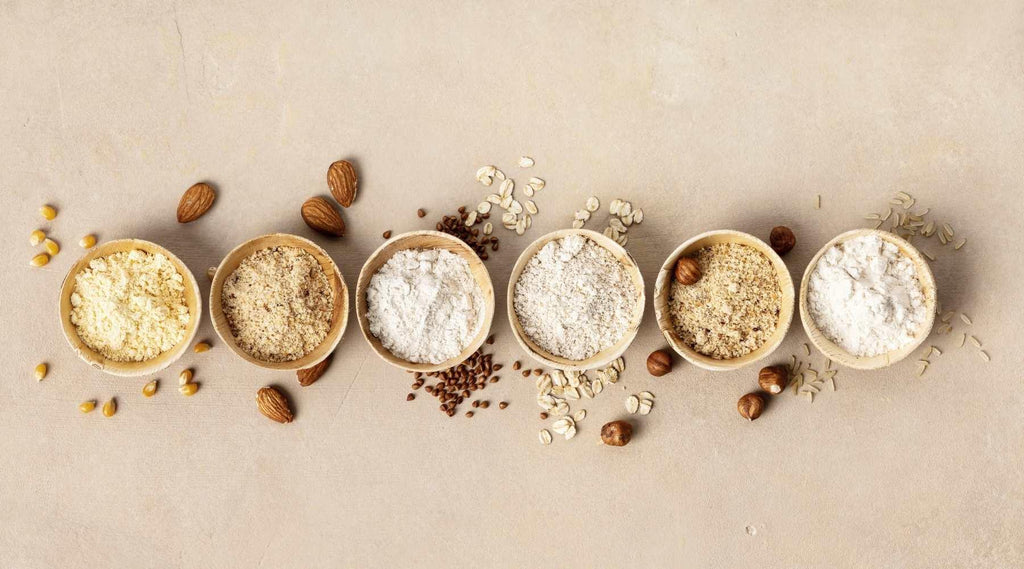
If you’ve been searching for a crash course on all things flour, you’ve come to the right place. In this article, we’ll go through the basics of all different types of flours, finding out why and how they’re suited for different recipes.
Whether you’re a budding baker, a cutting-edge chef, a gluten-free fanatic or a vegan virtuoso, you’re sure to find the flour for you.
Welcome the PlantX guide to all things flour.
What is Flour?

At its most basic, flour is a fine powder made up of ground grains. Usually made with wheat, flour is a pantry staple and one of the most elemental ingredients out there.
Flour’s main job is to provide structure and stability to recipes. Whether it’s binding together the sweet elements of a cake recipe or adding some thickness to a sauce, flour is all about texture.
Don’t all Flours do the Same Thing?
Yes, and no. While all types of flour are used for similar functions in recipes, the results vary depending on what flour you use. For example, some flours are great for making light, airy and delicate pastries. Others are used for stretchy, starchy, durable pasta recipes.
The reason flours vary so much comes down to their protein levels. Protein denotes how much potential a flour has to form gluten strands – that which helps baked goods retain shape and air.
To put it simply, you’ll want high-protein flour if you’re making something like bread. If you’re hoping to make tender, flaky cookies, you’ll want a low-protein flour.
Don’t be dismayed if you’re unsure what flour is best for you. A lot of them can be mixed and matched, so you can trial and error your way to find the perfect flour blend for you.
Different Types of Flour
Plain Flour
Let’s start off with the basics: plain flour. It’s the flour that started it all, the flour you’re probably most familiar with. Odds are you’ve got a bag of this nestled away in the back of your cupboard. How long has it been there? Who knows. But you know it’ll be there whenever you need it, as it’s the most versatile and readily accessible flour out there.
Plain flour, also known as all-purpose flour, is generally created from ground hard red winter wheat. It is a medium-gluten flour, meaning that it works well for a variety of purposes. Whether you’re mixing it into a sauce to thicken it up or making crepes for a Sunday morning treat, plain flour is always a safe bet. You can also get gluten-free four, such as this one by Ongran. It combines maize and rice flour which does an excellent job at replacing regular plain flour.
Self-Raising Flour
Next on the list is another classic: self-raising flour. Also known as self-rising flour, this baker’s classic is essentially just plain flour that’s been mixed with a raising agent. This allows it to expand during the baking process, giving recipes light and fluffy textures.
While self-raising flour is easy to buy, it’s also easy to make yourself. All you need to do is combine plain flour with a raising agent like Freee Gluten-Free Baking Powder. Just whisk 1 teaspoon of baking powder into 100g of plain flour, then use it in recipes just as you would a store-bought variety.
Cake Flour
If you fancy yourself a bit of a baking extraordinaire, it’s best you familiarise yourself with every pastry chef’s secret weapon: cake flour. Also known as soft flour, cake flour is made from soft wheat that’s been milled to be incredibly fine. The result is a light, thin and silky flour that’s perfect for baking.
Cake flour is a great flour to use if you’re hoping to create light and airy baked goods. Its low-protein, high-starch composition means it helps batters rise during the baking process. As an added bonus, cake flour has a relatively low gluten level, making for cakes, muffins and cupcakes that are both delicate and delicious.
Chestnut Flour
If you’re looking for a wheat-free alternative, chestnut flour is a great option for many vegan flour-based recipes. A staple in many Tuscan and regional Italian dishes, chestnut flour is great for making pasta or baking. You’re sure to love its subtly sweet and nutty flavour in whatever dish you put it in.
Naturally gluten-free and minimally processed, chestnut flour has a low protein count and a high starch count. It’s also very nutritious, containing high levels of potassium and all the rich minerals you’d find in chestnuts.
When baking, keep in mind that this gluten-free flour can’t be substituted for plain flour on its own. For every 150g of plain flour, we recommend using 120g of chestnut flour, as well as 30g of corn flour and ¼ teaspoon of baking powder.
If you’d like to experiment with chestnut flour, your best bet is to start off with Amisa Organic Gluten-Free Chestnut Flour.
Red Lentil Flour
Ah, lentils. They’re a vegan’s best friend; a rich source of protein, and high in loads of essential vitamins and nutrients. They’re also the base of red lentil flour, a gluten-free flour that’s a great substitute for many baked goods and flatbread recipes.
Red lentil flour is made from finely milled red lentils that have been dried and processed. The flour itself is high in protein, making it a sturdy and solid addition to your cooking.
Given its lack of gluten, red lentil flour isn’t great for recipes where you’re looking for height or lightness. Instead, consider using it to make things like crepes, tortillas and biscuits. We suggest trying Amisa Organic Gluten-Free Red Lentil Flour, a delicious and easy-to-use red lentil flour for budding gluten-free chefs.
Brown Rice Flour
Rice flour is a very popular flour loved by bakers and chefs alike. Commonly found in lots of Asian cuisines, rice flour is made from de-hulled rice grains that have been milled down into a fine powder. Gluten-free, versatile, and with a distinct nutty flavour, rice flour is a great ingredient to add to your arsenal.
If you’re thinking of starting to cook with rice flour, we recommend first trying brown rice flour, one like Amisa Organic Fine Milled Brown Rice Flour GF. Made with organic brown rice, this gluten-free flour a great way of infusing some dietary fibre into your cooking.
Brown rice flour also requires additional raising agents if you’re planning on making something like bread. Common additions include xanthan gum as a stabiliser or other flours like corn flour.
Coconut Flour
If you’re looking to explore grain-free baking and cooking, then coconut flour is the best option for you. Coconut flour is made by shredding the pulp of fried coconuts, then milling it into a fine powder. With its distinct coconut-y flavour and aroma, you’ll be going coconuts for this vegan flour in no time.
Coconut flour is a rich source of iron, magnesium, fibre and protein. It’s also keto-friendly, making it a delicious base for many vegan and keto baked goods. While it’s not the best flour for pasta dishes or bread, it makes for excellent cookies or biscuits.
Ready to start baking with coconut flour? Check out Clearspring Organic Gluten-Free Coconut Flour. It’s made with rich Sri Lankan coconuts, and it’s 100% organic. We suggest mixing a spoon of it into your smoothie for some thick coconut-y goodness.
Hemp Seed Flour
All hail hemp, the wonder plant! These days, it seems like hemp products are popping up everywhere. But that’s for a good reason. Hemp is high in protein, high in fibre, and a delicious gluten-free alternative for your cooking.
Hemp seed flour is made from dried and milled hemp seeds. It’s keto-friendly, gluten-free, and jam packed with a lot of essential vitamins and nutrients.
Again, you’ll need a raising agent and a stabiliser to retain air in recipes using hemp seed flour. As hemp seed flour is very dense, it’s a great addition to many cookie, biscuit and brownie recipes. The result will be ooey-gooey, protein-rich hemp delights.
The PlantX team has selected Good Hemp Hemp Seed Flour as the hemp seed flour MVP. Grab yourself a bag today and revolutionise your gluten-free baking game.
Getcha Bake On
So, now you’ve learned all you need to know about flour, it’s time to get out there and apply your knowledge.
Use our Ultimate Guide to Flour and find the perfect flour for your next vegan flour based recipe.
Happy baking!









